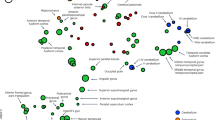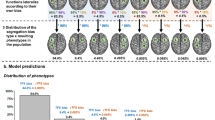Abstract
This is the seventh ERIC/ECTJ Annual Review Paper, preparation of which was supported by the ERIC (Educational Resources Information Center) Clearing-house on Information Resources, Syracuse University. The material in this article was prepared pursuant to a contract with the National Institute of Education, U.S. Department of Education. Contractors undertaking such projects under government sponsorship are encouraged to express freely their judgment in professional and technical matters. Points of view or opinions do not necessarily represent the official view or opinion of the NIE. - Ed.
Similar content being viewed by others
Reference Notes
Zaidel, E.Dichotic listening and hemispheric specialization in the split brain: A case study. Paper presented at the 17th annual meeting of the Academy of Aphasia, San Diego, Calif., October 15, 1979.
Kinsbourne, M.Developmental studies of verbal-manual time sharing. Paper presented at the 17th annual meeting of the Academy of Aphasia, San Diego, Calif., October 15, 1979.
Gardner, H., Hamby, S., Wapner, W., Cicone, M., Michel, D., & Shapiro, B.The role of the right hemisphere in the organization of linguistic materials. Paper presented at the 17th annual meeting of the Academy of Aphasia, San Diego, Calif., October 15, 1979.
Clark, R. E.Visual instruction and visual aptitude. Paper submitted for publication, May 1, 1979.
References
Ausburn, L. J., & Ausburn, F. B. Cognitive styles: Some information and implications for instructional design.Educational Communication and Technology, 1978,26, 337–354.
Berlin, C. I. Hemisphere asymmetry in auditory tasks. In S. Harnad, R. Doty, L. Goldstein, J. Jaynes, & G. Krauthamer (Eds.),Lateralization in the nervous system. New York: Academic Press, 1977.
Berlin, C. I., & McNeil, M. R. Dichotic listening. In N. J. Lass (Ed.),Contemporary issues in experimental phonetics. New York: Academic Press, 1976.
Broca, P. Sur la faculte du langage articule.Bulletin Societe Anthropologia, 1865,6, 493–494.
Bryden, M. P. Evidence for sex differences in cerebral organization. In M. A. Wittig & A. C. Petersen (Eds.),Sex-related differences in cognitive functioning: Developmental issues. New York: Academic Press, 1978. (a)
Bryden, M. P. Strategy effects in the assessment of hemispheric asymmetry. In G. Underwood (Ed.),Strategies of information processing. London: Academic Press, 1978. (b)
Bryden, M. P., & Allard, F. Visual hemifield differences depend on typeface.Brain and Language, 1976, 3, 191–200.
Caramazza, A., & Berndt, R. S. Semantic and syntactic processes in aphasia: A review of the literature.Psychological Bulletin, 1978,85, 898–918.
Carrier, C. A., & Clark, R. E. Effects of presentation modes, explicitness, and student aptitudes on learning.Educational Communication and Technology, 1978,26, 329–336.
Case, R. A developmentally based theory and technology of instruction.Review of Educational Research, 1978, 48, 439–463.
Clark, R. L. Media, mental imagery, and learning.Educational Communication and Technology, 1978,26, 355–363.
Cohen, G. Hemisphere differences in the effects of cueing.Journal of Experimental Psychology: Human Perception and Performance, 1975,1, 366–373.
Cohen, G.The psychology of cognition. London: Academic Press, 1977.
Day, J. Right-hemisphere language processing in normal right handers.Journal of Experimental Psychology: Human Perception and Performance, 1977,3, 518–528.
de Renzi, E. Hemispheric asymmetry as evidenced by spatial disorders. In M. Kinsbourne (Ed.),Asymmetrical function of the brain. Cambridge: Cambridge University Press, 1978.
Dimond, S.The double brain. Baltimore: Williams and Wilkins, 1972.
Donchin, E., Kutas, M. & McCarthy, G. Electrocortical indides of hemispheric utilization. In S. Harnad, R. Doty, L. Goldstein, J. Jaynes, & G. Krauthamer (Eds.),Lateralization in the nervous system. New York: Academic Press, 1977.
Ehrlichman, H. & Weinberger, A. Lateral eye movements and hemispheric asymmetry: A critical review.Psychological Bulletin, 1978,85, 1080–1101.
Ellis, H. D. & Shepherd, J. W. Recognition of abstract and concrete words presented in the left and right visual fields.Journal of Experimental Psychology, 1974, 203, 1035–1036.
Galambos, R., Benson, P., Smith, T. S., Schulman-Galambos, C. & Osier, H. On hemispheric differences in evoked potentials to speech stimuli.Electroencephalography and Clinical Neuropsychology, 1975,39, 279–283.
Galin, D. & Ellis, R. R. Asymmetry in evoked potentials as an index of lateralized cognitive processes: Relation to EEG alpha asymmetry.Neuropsychologia, 1975,13, 45–50.
Galin, D. & Ornstein, R. Lateral specialization of cognitive mode: An EEG study.Psychophysiology, 1972,9, 412–418.
Gardner H.The shattered mind. New York: Vintage Books, 1974.
Gardner, H. What we know (and don’t know) about the two halves of the brain.Harvard Magazine, 1978,80, 24–27.
Gazzaniga, M. S.The bisected brain. New York: Appelton-Century-Crofts, 1970.
Gazzaniga, M. S., & Le Doux, J.The integrated mind. New York: Plenum, 1978.
Geffen, G., Bradshaw, J. L., & Nettleton, N. C. Attention and hemispheric differences in reaction time during simultaneous audio-visual tasks.Quarterly Journal of Experimental Psychology, 1973, 25, 404–412.
Geschwind, N. The organization of language and the brain.Science, 1970, 270, 940–944.
Glaser, R. Components of a psychology of instruction: Toward a science of design.Review of Educational Research, 1976,46, 1–24.
Glaser, R., & Resnick, L. B. Instructional psychology. In P. Mussen & M. Rosenzweig (Eds.),Annual Review of Psychology, 1972,23, 181–276.
Glass, A. L., Holyoak, K. S. & Santa, J. L.Cognition. Reading, Mass.: Addison-Wesley, 1979.
Gur, R. & Gur, R. Correlates of conjugate lateral eye movements in man. In S. Harnad, R. Doty, L. Goldstein, J. Jaynes, & G. Krauthamer (Eds.),Lateralization in the nervous system. New York: Academic Press, 1977.
Guyer, L. B., & Friedman, M. P. Hemispheric processing and cognitive styles in learningdisabled and normal children.Child Development, 1975,46, 658–668.
Haber, R. N. Introduction.Information processing approaches to visual perception. New York: Holt, Rinehart & Winston, 1969.
Hannay, H. J. Real or imagined incomplete lateralization of function in females?Perception & Psychophysics, 1976, 19, 349–352.
Hardyck, C., & Petrinovich, L. F. Left-handedness.Psychological Bulletin, 1977,84, 385–404.
Hellige, J.B. Changes in same-different laterality patterns as a function of practice and stimulus quality.Perception & Psychophysics, 1976,20, 267–273.
Hellige, J. B. Effects of perceptual quality and visual field of probe stimulus presentation on memory search for letters.Journal of Experimental Psychology: Human Perception and Performance, in press. (a)
Hellige, J. B. Visual laterality and cerebral hemisphere specialization: Methodological and theoretical considerations. In J. B. Sidowski (Ed.),Conditioning, cognition, and methodology: Contemporary issues in experimental psychology. Hillsdale, N.J.: Lawrence Erlbaum Associates, in press. (b)
Hellige, J. B. & Cox, P. J. Effects of concurrent verbal memory on recognition of stimuli from the left and right visual fields.Journal of Experimental Psychology: Human Perception and Performance, 1976, 2, 210–221.
Hellige, J. B., Cox, P. J., Litvac, L. Information processing in the cerebral hemispheres: Selective hemispheric activation and capacity limitations.Journal of Experimental Psychology: General, 1979,108, 251–279.
Hellige, J. B. & Webster, R. Right hemisphere superiority for initial stages of letter processing.Neuropsychologia, 1979,17, 653–660.
Herron, J., Galin, D., Johnstone, J., & Omstein, R. E. Cerebral specialization, writing posture, and motor control of writing in left-handers.Science, 1979,205, 1285–1289.
Hicks, R. E. Intrahemispheric response competition between vocal and unimanual performance in normal adult human males.Journal of Comparative and Physiological Psychology, 1975,89, 50–60.
Hines, D. Recognition of verbs, abstract nouns, and concrete nouns from the left and right visual half-fields.Neuropsychologia, 1976,13, 27–33.
Johnson, O. & Kozma, A. Effects of concurrent verbal and musical tasks on a unimanual skill.Cortex, 1977,13, 11–16.
Kimura, D. Cerebral dominance and the perception of verbal stimuli.Canadian Journal of Psychology, 1961,15, 166–171.
Kimura, D. Speech lateralization in young children as determined by an auditory test.Journal of Comparative and Physiological Psychology, 1963, 56, 899–902.
Kimura, D. Left-right differences in the perception of melodies.Quarterly Journal of Experimental Psychology, 1964,16, 355–358.
Kimura, D. Dual functional asymmetry of the brain in visual perception.Neuropsychologia, 1966,4, 275–285.
Kimura, D. Spatial localization in left and right visual fields.Canadian Journal of Psychology, 1969,23, 445–458.
Kimura, D. The asymmetry of the human brain.Scientific American, 1973,228, 70–78.
Kinsbourne, M. Eye and head turning indicates cerebral lateralization.Science, 1972,176, 589–591.
Kinsbourne, M. Direction of gaze and distribution of cerebral thought processes.Neuropsychologia, 1974,12, 279–281.
Kinsbourne M. (Ed.).Asymmetrical function of the brain. Cambridge: Cambridge University Press, 1978.
Kinsbourne, M., & Cook, J. Generalized and lateralized effects of concurrent verbalization on a unimanual skill.Quarterly Journal of Experimental Psychology, 1971,23, 341–345.
Kroll, N. E. A., & Madden, D. J. Verbal and pictorial processing by hemisphere as a function of the subject’s Scholastic Aptitude Test score. In J. Requin (Ed.),Attention and performance VII. Hillsdale, N.J.: Lawrence Erlbaum Associates, 1978.
Levy, J. & Reid, M. L. Variations in cerebral organization as a function of handedness, hand posture in writing, and sex.Journal of Experimental Psychology: General, 1978,107, 119–144.
Madden, D. J., & Nebes, R. D. Visual perception and memory. In M. D. Wittrock (Ed.),The brain and psychology. New York: Academic Press, in press.
Massaro, D. W.Experimental psychology and information processing. Chicago: Rand-McNally, 1975.
Mayes, A. & Beaumont, G. Does visual evoked potential asymmetry index cognitive activity?Neuropsychologia, 1977,15, 245–256.
McKeever, W. F. Does post-exposure directional scanning offer a sufficient explanation for lateral differences in tochistoscopic recognition?Perceptual and Motor Skills, 1974,38, 43–50.
Milner, B. Interhemispheric differences and psychological processes.British Medical Bulletin, 1971,27, 272–277.
Milner, B., Taylor, L. & Sperry, R. Lateralized suppression of dichotically presented digits after commissural section in man.Science, 1968,161, 184–186.
Molfese, D. L. Infant cerebral asymmetry. In S. J. Segalowitz & F. A. Gruber (Eds.),Language development and neurological theory. New York: Academic Press, 1977.
Moscovitch M. Information processing and the cerebral hemispheres. In M. S. Gazzaniga (Ed.),Handbook of behavioral neurobiology (Vol. 2). New York: Plenum Press, 1979.
Moscovitch, M., Scullion, D. & Christie, D. Early versus late stages of processing and their relation to functional hemispheric asymmetries in face recognition.Journal of Experimental Psychology: Human Perception and Performance, 1976,2, 401–416.
Moscovitch, M. & Smith, L. C. Differences in neural organization between individuals with inverted and noninverted handwriting postures.Science, 1979,205, 710–713.
Patterson, K. & Bradshaw, J. L. Differential hemispheric mediation of nonverbal visual stimuli.Journal of Experimental Psychology: Human Perception and Performance, 1975,1, 246–252.
Polich, J. M. Hemispheric differences in stimulus identification.Perception & Psychophysics, 1978,24, 49–57.
Rizzolatti, G., & Buchtel, H. A. Hemispheric superiority in reaction time to faces: A sex difference.Cortex, 1977,13, 300–305.
Salomon, G. Heuristic models for the generation of aptitude-treatment interaction hypotheses.Review of Educational Research, 1971,42, 327–343.
Segalowitz, S. J., & Gruber, F. A. (Eds.).Language development and neurological theory. New York: Academic Press, 1977.
Spellacy, F. & Blumstein, S. The influence of language set on ear preference in phoneme recognition.Cortex, 1970,6, 430–439.
White, M. J. Laterality differences in perception: A review.Psychological Bulletin, 1969,72, 387–405.
White, M. J. Hemispheric asymmetries in tachistoscopic information processing.British Journal of Psychobgy, 1972,63, 497–508.
Witelson, S. F. Hemispheric specialization for linguistic and nonlinguistic tactual perception using a dichotomous stimulation technique.Cortex, 1974,10, 3–17.
Witelson, S. F. Sex and the single hemisphere: Specialization of the right hemisphere for spatial processing.Science, 1976,193, 425–427.
Witelson, S. F. Developmental dyslexia: Two right hemispheres and none left.Science, 1977,195, 309–311.
Author information
Authors and Affiliations
Additional information
The author’s own research discussed in this article was supported in part by research grants from the National Institute of Mental Health and from the National Science Foundation.
Rights and permissions
About this article
Cite this article
Hellige, J.B. Cerebral hemisphere asymmetry: Methods, issues, and implications. ECTJ 28, 83–98 (1980). https://doi.org/10.1007/BF02766402
Issue Date:
DOI: https://doi.org/10.1007/BF02766402




